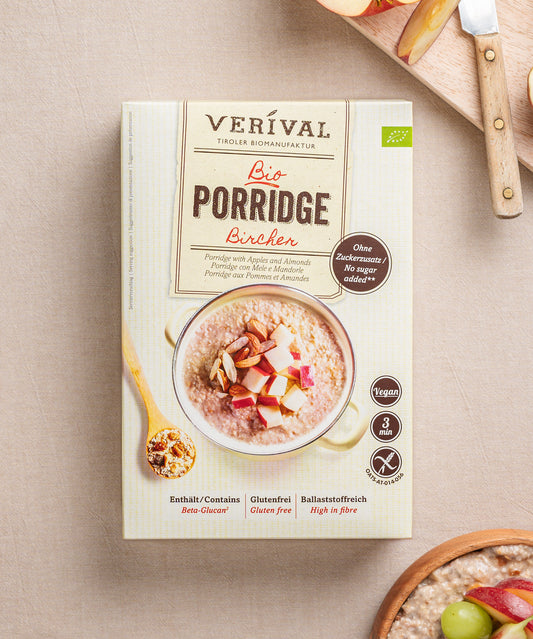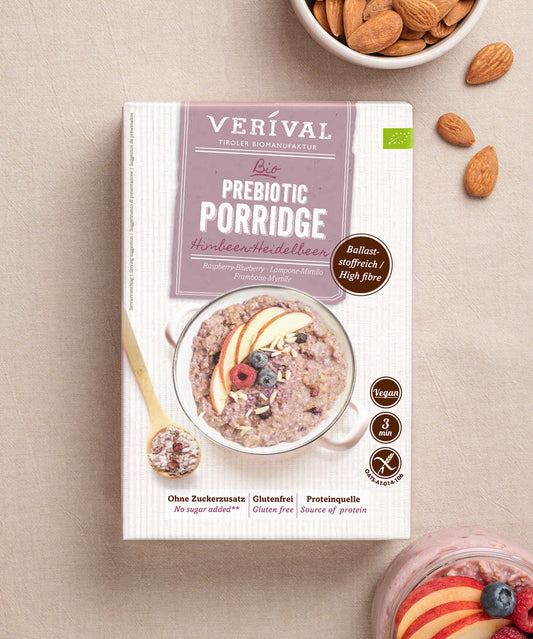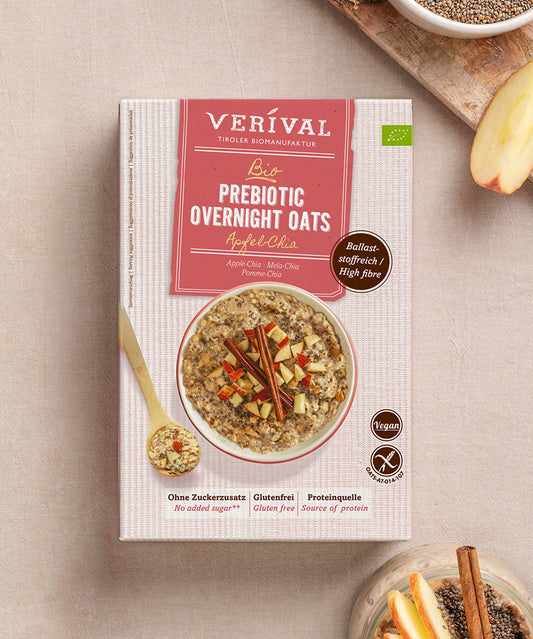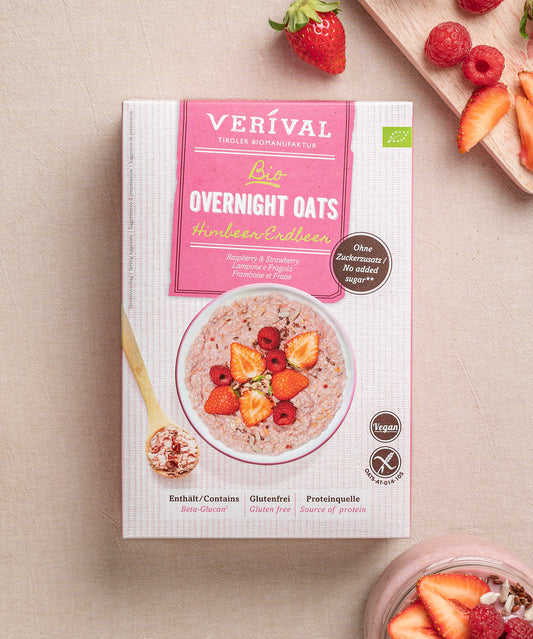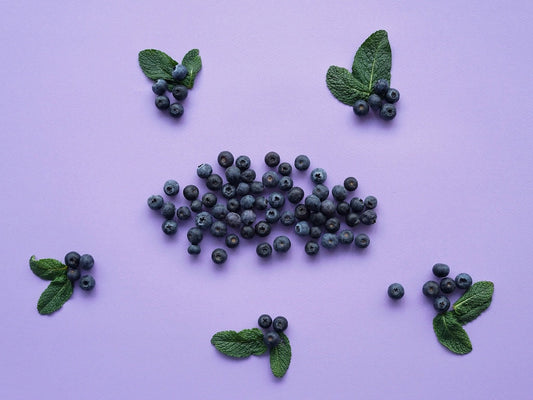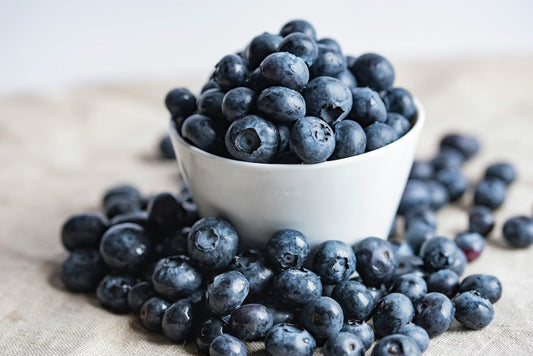This article will give you a comprehensive insight into the positive effects of oat bran. We would also like to provide you with information about possible side effects. After all, there are always a few aspects to consider when trying to reap the benefits. So get ready to learn all about the many uses of oat bran!
Everything you need to know about oat bran
Oat bran is full of nutrients – Nutritional values table
| Nutritional values of oat bran | Content in 100 g of oat bran | Covering the daily requirement with 20 g of oat bran |
| Calories/energy | 359 kcal | 3.6 % |
| Protein | 14.5 g | 5.8 % |
| Carbohydrates | 54.6 g | 4.2 % |
| of which sugar | 1.3 g | 0.3 % |
| Fat | 6.6 g | 1.9 % |
| of which polyunsaturated fatty acids | 2.8 g | 2.8 % |
| Dietary fiber | 11.2 g | 7.5 % |
| of which beta glucan | 6.2 g | 41.3 % |
| Vitamin B1 | 0.85 mg | 15.5 % |
| Iron | 4.2 mg | 6.3 % |
| Magnesium | 160 mg | 8.5 % |
Micronutrients are abundant in oat bran and play a crucial role in supporting and maintaining your body's vital functions. Oat bran contains a variety of minerals, trace elements and vitamins that are important for the smooth running of all metabolic processes, your mental well-being and an effective immune defense.
The use of oat bran in your diet is extremely flexible. You can add them raw directly to muesli, smoothies or savory dishes. There is no absolute necessity to cook or soak the bran.
Nevertheless, it is recommended to let oat bran swell, as it contains phytic acid, which can impair the absorption of nutrients. Soaking, preferably in liquids such as (vegetable) milk or water for at least 30 minutes, reduces the phytic acid content because enzymes called phytases are present. This leads to a better absorption of nutrients, minerals and trace elements in your digestive tract.
Oat bran satisfies you and helps you avoid food cravings.
Oat bran contains more fiber than rolled oats, including large amounts of beta-glucan (100 g of oat bran contain 6.2 grams of beta-glucan) – one of the reasons why oat bran is so healthy.
This substance is soluble in water and forms a kind of gel-like paste in the gastrointestinal tract. This is slowly and steadily passed through your digestive tract, delaying the absorption of nutrients and the increase in blood sugar levels.
This prolongs satiety and inhibits the onset of cravings. You consume the right food, so to speak, and consequently absorb less unnecessary energy.
The superfood protects you from heart disease
Heart disease is now one of the leading causes of death.
One major factor in heart disease is high cholesterol levels. The beta-glucans in oat bran can help produce bile juices and excrete more cholesterol-rich bile. This in turn means that you have less cholesterol in your blood and your cholesterol level drops. In addition, beta-glucans are water-soluble fibers that slow the absorption of nutrients, including fat and cholesterol.
Another risk factor for heart disease is high LDL (also known as bad cholesterol). If your LDL level is constantly too high, it can cause inflammation in your arteries and increase your risk of heart attack and stroke.
Antioxidants protect your body cells
Antioxidants are your body's defense mechanisms against the harmful effects of free radicals, which may be linked to age-related chronic diseases.
Oat bran is particularly high in avenanthramides, an antioxidant that increases the production of nitric oxide. This helps to lower blood pressure because nitric oxide dilates blood vessels, thus improving blood flow.
In addition, the antioxidant properties of oat bran also have a soothing effect on itching and inflammation.
Oat bran regulates blood sugar levels
A widespread problem of our modern diet is the increase in blood sugar levels due to the excessive consumption of sugary and processed foods. These eating habits, which are often high in sugar and refined carbohydrates, can increase the risk of developing type 2 diabetes mellitus, especially in overweight people.
Oat bran can be a valuable tool in this context, as it improves insulin sensitivity through the beta-glucans it contains. These dietary fibers allow more glucose to pass from the blood into the cells, causing blood sugar levels to drop. This positive effect is attributed to the ability of beta-glucan to form a gel-like food slurry in the gastrointestinal tract. This slows the emptying of the stomach, and the absorption of glucose into the blood takes place very gradually.
Especially for people who already suffer from type 2 diabetes mellitus, oat bran can be a valuable and useful addition to their diet. It helps to better control blood sugar levels and keep them at a stable level.
The bran, the most valuable part of the oat grain, helps you lose weight.
Oat bran truly deserves the “superfood” label. This is not only because of its low calorie density. Oat bran has impressive properties for controlling appetite and promoting healthy digestion.
One remarkable effect of oat bran is the formation of a gel-like food pulp in your digestive tract. This causes food to move slowly through the stomach and intestines, resulting in a gradual absorption of nutrients. The result is a slow rise in blood sugar levels and long-lasting satiety, helping you avoid unwanted cravings.
In addition, beta-glucan can increase the release of PYY (a special peptide hormone) which is released in the intestines in response to food and has a satiating effect. Oat bran can therefore increase the release of this satiety hormone, thus reducing food and calorie intake. The risk of obesity can thus be reduced and a normalization of body weight can be facilitated.
Even with low carb, oat bran is often used because the oat product can help you lose weight wonderfully.
Possible side effects of oat bran
There is a recommendation for the daily amount of oat bran, which is 30-40 grams. In any case, it is advisable to approach this amount cautiously. This is because oat bran is high in fiber, which your digestive tract needs to get used to slowly, and you may experience occasional constipation or bloating at first.
Digestive discomfort is the only side effect that can occur when consuming oat bran if you do not drink enough. Drinking plenty of fluids is a prerequisite for you to get the full health benefits of oat bran and avoid any unpleasant side effects.
Caution is advised for those with celiac disease, as oat products are usually contaminated by other types of grain. You can eat oat bran if you make sure to buy oat bran that is explicitly labeled gluten-free.
Everything you need to know about oat bran
Frequently asked questions
Does oat bran have side effects?
Oat bran is usually well tolerated and rarely has side effects. However, excessive consumption of oat bran can cause digestive discomfort in some people. This is due to the high fiber content, especially the soluble fibers such as beta-glucans, which are found in oat bran. These fibers have the ability to bind water and form a gel-like substance that increases the volume of stool. If you consume oat bran in excessive amounts and do not drink enough, you may experience constipation.
Can you eat oat bran every day?
Yes, most people can easily incorporate oat bran into their daily diet. A daily serving of about 30 to 40 grams of oat bran is recommended and offers many health benefits. This amount contains enough soluble fiber, especially beta-glucans, to exert positive effects on cholesterol and blood sugar levels without usually causing side effects. However, it is important to adjust the amount of oat bran according to individual needs and tolerances. A gradual increase in the amount can help to avoid possible digestive problems.
What does oat bran do in the gut?
Oat bran has various effects in the gut due to its high fiber content, especially soluble fibers such as beta-glucans. When oat bran is ingested, the fibers bind water and form a gel-like substance. This substance increases stool volume and promotes peristalsis, the movement of the intestines. This aids digestion and can prevent constipation. The soluble fiber can also stabilize blood sugar levels by delaying the absorption of glucose. In addition, oat bran lowers cholesterol by promoting the formation of bile acids, which remove cholesterol from the body.
How does oat bran affect the body?
Oat bran has a positive effect on the body in a number of ways. The soluble fiber in oat bran stabilizes blood sugar levels by slowing the absorption of glucose in the intestines. This is particularly beneficial for people with diabetes or those who want to control their blood sugar levels. In addition, beta-glucans can lower cholesterol levels, especially LDL cholesterol, which is known as “bad” cholesterol. This reduces the risk of heart disease. Oat bran can also help with weight control because it gives you a long-lasting feeling of satiety and reduces cravings. In addition, the bran contains many other valuable ingredients such as manganese, magnesium, folic acid, selenium, zinc and iron. The nutrients are rounded off by vitamins B1, B2 and B5.
Is oat bran difficult to digest?
Oat bran is usually easy to digest, especially if you prepare it properly. The soluble fiber in oat bran, such as beta-glucans, can actually help support your digestion and prevent constipation. However, it is recommended to let oat bran soak in enough liquid, such as (plant-based) milk or water, before eating it. This helps to reduce the phytic acid in the oat bran, which can inhibit the absorption of nutrients. Soaking allows the enzymes it contains to break down the phytic acid and make the minerals and trace elements more readily available. Therefore, oat bran, when prepared properly, is not difficult to digest and can be easily integrated into your daily diet.
What is beta-glucan?
Unfortunately, beta-glucan is not yet as well known as it should be. It has a wide range of positive effects on human health. The fiber beta-glucan is found in oatmeal and oat bran and has been shown to lower blood cholesterol levels, for example. Oat bran has a very high beta-glucan content.
What is the difference between oat flakes and oat bran?
Both oat products, oat bran and oat flakes, are versatile, wholesome, wholegrain products and extremely healthy foods. While oat flakes are made from the whole grain, oat bran is composed of the outermost layers of the grain, which are rich in nutrients and fiber: the outer layers and the germ bud.



